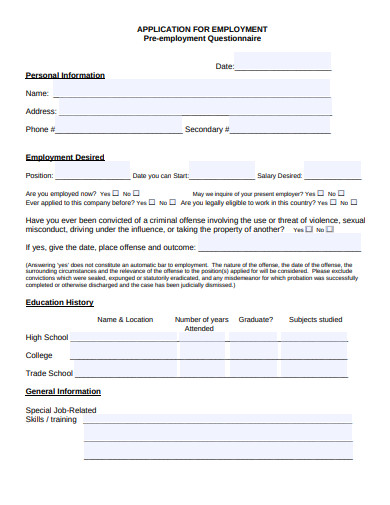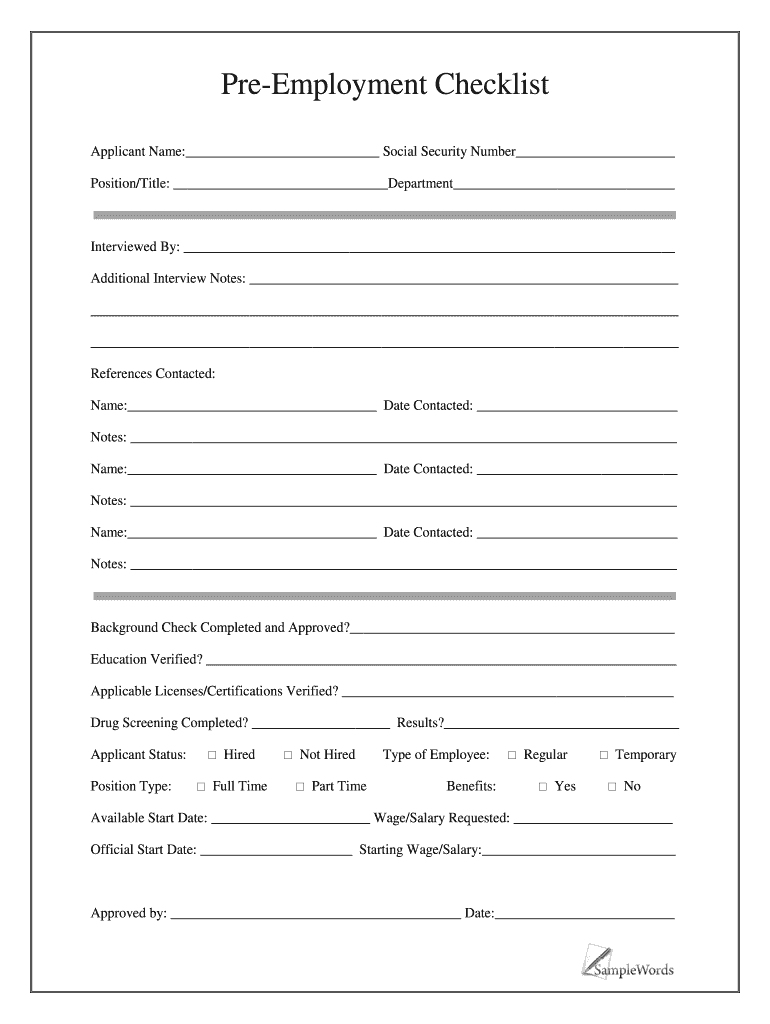5 Things to Know About Pre-Employment Paperwork

Getting your first job or changing your career path can be a thrilling yet nerve-wracking experience. Amidst the excitement of a new beginning, there's a less glamorous aspect that often gets overlooked: pre-employment paperwork. These documents are more than just a formality; they are crucial for both the employer and employee, ensuring that all legalities and requirements are met before work begins. Here are five key things you need to know about pre-employment paperwork:
1. What to Expect in Your Pre-Employment Paperwork?

The bundle of paperwork you’ll encounter before starting a new job can include:
- Employment Application Form: If not filled out already, this form captures your personal information, job experience, and references.
- I-9 Form: This document verifies your eligibility to work in the United States.
- W-4 Form: Used to determine the amount of federal tax to withhold from your paycheck.
- Direct Deposit Authorization: To set up your payroll directly into your bank account.
- Employee Handbook or Company Policies: Documents outlining expected behavior and company policies you must agree to.
- Benefits Enrollment: Papers or forms related to health insurance, retirement plans, and other employee benefits.
- Confidentiality or Non-Compete Agreements: Contracts protecting the company’s proprietary information.
💡 Note: Not every job will require all these documents, but being prepared to deal with any or all can save you time and stress.
2. The Importance of Completing Paperwork Properly

It might feel tedious, but accurate completion of pre-employment paperwork is important for several reasons:
- Legal Compliance: Proper documentation ensures both employer and employee adhere to legal standards regarding employment, taxes, and benefits.
- Payroll Setup: Incorrect W-4 information can lead to tax issues, while improper direct deposit details can delay your pay.
- Benefit Enrollment: Filling out the wrong forms or dates can result in missing out on critical benefits or enrolling at an improper time.
- Future Reference: Clear and correct documentation can be vital for future reference in disputes or for legal purposes.
By doing it right the first time, you avoid potential complications down the line.
3. Tips for Managing Pre-Employment Paperwork

To streamline your pre-employment paperwork process:
- Stay Organized: Keep all forms together and perhaps use a checklist to track what you’ve completed.
- Read Carefully: Take the time to read each document, understanding what you’re agreeing to or providing.
- Ask Questions: If something is unclear, seek clarification from HR or your future supervisor.
- Keep Copies: Always make copies of everything you submit for your records.
- Use Electronic Options: If available, electronic submission can often speed up the process and reduces errors.
💡 Note: A well-organized approach reduces the chance of missing any critical documents or information.
4. Common Issues and How to Solve Them

Navigating pre-employment paperwork can occasionally lead to hurdles:
- Missing Documents: If you’re missing a document, contact your prospective employer or HR to clarify what’s needed or how to obtain it.
- Incorrect Information: Fill out forms accurately, or if you find errors, correct them before submission.
- Delays in Processing: Communicate with HR if you anticipate any delays due to external factors like visa processing.
Being proactive and communicative can often resolve these issues swiftly.
5. The Role of Background Checks

Many employers conduct pre-employment background checks, which might include:
- Criminal Records: Check for any criminal history.
- Education Verification: Confirming degrees or qualifications.
- Credit Checks: For positions involving financial responsibilities.
- Reference Checks: Verifying employment history and obtaining character references.
- Drug Testing: Depending on the nature of the job.
These checks ensure you’re a good fit for the role, with the following considerations:
- Understanding your rights: The Fair Credit Reporting Act and similar laws protect employees during background checks.
- Disclosure: Employers must inform you of the check and obtain your consent.
- Right to review: You have the right to review and dispute any findings from the background check.
In summary, pre-employment paperwork is a vital step in the onboarding process, ensuring legal compliance, setting up payroll, and providing necessary benefits. It's important to approach this phase with organization and attention to detail, staying proactive in clarifying any uncertainties. Despite potential delays or issues, maintaining communication with your future employer will help resolve any problems. Remember, accurate and timely completion of these forms sets the stage for a smooth start to your new job or career change.
What is the purpose of the I-9 Form?

+
The I-9 Form is used to verify the identity and employment authorization of individuals hired for employment in the United States. It ensures compliance with U.S. immigration laws.
Can I change the information on my W-4 form after I’ve started working?

+
Yes, you can update your W-4 form at any time if your financial situation changes, such as getting married, having a child, or experiencing changes in income.
What happens if I fail a background check?

+
If you fail a background check, your employer will inform you of the adverse decision, and you’ll have the opportunity to review the report, dispute any inaccuracies, and provide an explanation or additional context.